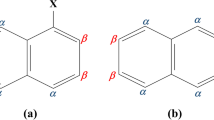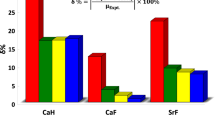Abstract
The feature of positron binding to twenty neutral amino acid molecules with the global minimum (GM) and intramoleculear hydrogen-bonded (HB) structures was analysed using the ab initio multi-component molecular orbital method. All amino acid molecules in the intramoleculear HB structures have positive positron affinity (PA, the binding energy of a positron) values, which means that a positron can be attached to parent molecules, while in the GM structures only three amino acid molecules of Gln, Trp, and His have positive PA values. Analysing the positronic orbitals of each positronic amino acid molecule and the electrostatic potential maps of the corresponding parent molecules, we found that long-range electrostatic interaction is the most crucial role in positron binding to neutral amino acid molecules. The strong correlation is observed between the PA and dipole moment, that is, a polar molecule with a large dipole moment has a large PA value. The critical dipole moment of neutral amino acid molecules for binding a positron was found at about 3.46 Debye. From the systematic analysis of twenty kinds of amino acid molecule, we theoretically confirmed the possibility of positron binding to conformers of amino acid molecules with strong dipole moment.
Similar content being viewed by others
References
New directions in Antimatter Chemistry and Physics, edited by C.M. Surko, F.A. Gianturco (Kluwer Academic Publishers, The Netherlands, 2001)
G.F. Gribakin, J.A. Young, C.M. Surko, Rev. Mod. Phys. 82, 2557 (2010)
L. Sokoloff, M. Reivich, C. Kennedy, M.H. Des Rosiers, C.S. Patlak, K.D. Pettigrew, O. Sakurada, M. Shinohara, J. Neurochem. 28, 897 (1977)
J.R. Danielson, J.A. Young, C.M. Surko, J. Phys. B 42, 235203 (2009)
J.A. Young, C.M. Surko, Phys. Stat. Sol. C 6, 2265 (2009)
J.R. Danielson, J.J. Gosselin, C.M. Surko, Phys. Rev. Lett. 104, 233201 (2010)
O.H. Crawford, Proc. Phys. Soc. 91, 279 (1967)
O.H. Crawford, Mol. Phys. 20, 585 (1971)
H. Chojnacki, K. Strasburger, Mol. Phys. 104, 2273 (2006)
Y. Kita, R. Maezono, M. Tachikawa, M. Towler, R.J. Needs, J. Chem. Phys. 131, 134310 (2009)
R.J. Buenker, H.-P. Liebermann, V. Melnikov, M. Tachikawa, L. Pichl, M. Kimura, J. Phys. Chem. A 109, 5956 (2005)
F.A. Gianturco, J. Franz, R.J. Buenker, H.-P. Liebermann, L. Pichl, J.-M. Rost, M. Tachikawa, M. Kimua, Phys. Rev. A 73, 022705 (2006)
Y. Kita, R. Maezono, M. Tachikawa, M. Towler, R.J. Needs, J. Chem. Phys. 135, 054108 (2011)
K. Strasburger, Struct. Chem. 15, 415 (2004)
M. Tachikawa, R.J. Buenker, M. Kimura, J. Chem. Phys. 119, 5005 (2003)
M. Tachikawa, Y. Kita, R.J. Buenker, Phys. Chem. Chem. Phys. 13, 2701 (2011)
D. Yu, D.A. Armstrong, A. Rauk, Can. J. Chem. 70, 1762, (1992)
S. Gronert, R.A.J. O’Hair, J. Am. Chem. Soc. 117, 2071 (1995)
M. Tachikawa, H. Sainowo, K. Iguchi, K. Suzuki, J. Chem. Phys. 101, 5925 (1994)
T. Saito, M. Tachikawa, C. Ohe, K. Iguchi, K. Suzuki, J. Phys. Chem. 100, 6057 (1994)
S.L. Saito, F. Sasaki, J. Chem. Phys. 102, 8040 (1995)
M. Tachikawa, Chem. Phys. Lett. 350, 269 (2001)
M.W.J. Bromley, J. Mitroy, Phys. Rev. A 65, 062505 (2002)
K. Strasburger, J. Chem. Phys. 114, 00615 (2001)
S. Bubina, L. Adamowicz, J. Chem. Phys. 120, 6051 (2004)
J. Mitroy, Phys. Rev. A 73, 054502 (2006)
D.M. Schrader, T. Yoshida, K. Iguchi, Phys. Rev. Lett. 68, 3281 (1992)
N. Jiang, D.M. Schrader, J. Chem. Phys. 109, 9430 (1998)
D. Bressanini, M. Mella, G. Morosi, J. Chem. Phys. 108, 4756 (1998)
M. Mella, M. Casalegno, G. Morosi, J. Chem. Phys. 117, 1450 (2002)
P.E. Cade, A. Farazdel, J. Chem. Phys. 66, 2598 (1977)
C.M. Kao, P.E. Cade, J. Chem. Phys. 80, 3234 (1984)
M. Tachikawa, K. Mori, K. Suzuki, K. Iguchi, Int. J. Quant. Chem. 70, 491 (1998)
M. Tachikawa, K. Mori, H. Nakai, K. Iguchi, Chem. Phys. Lett. 290, 437 (1998)
M.J. Frisch et al., GAUSSIAN 03, Revision B.05 (Gaussian, Inc., Pittsburgh, 2003)
T.C. Dinadayalane, G.N. Sastry, J. Leszczynski, Int. J. Quant. Chem. 106, 2920 (2006)
Author information
Authors and Affiliations
Corresponding author
Rights and permissions
About this article
Cite this article
Koyanagi, K., Kita, Y. & Tachikawa, M. Systematic theoretical investigation of a positron binding to amino acid molecules using the ab initio multi-component molecular orbital approach. Eur. Phys. J. D 66, 121 (2012). https://doi.org/10.1140/epjd/e2012-20638-y
Received:
Revised:
Published:
DOI: https://doi.org/10.1140/epjd/e2012-20638-y




